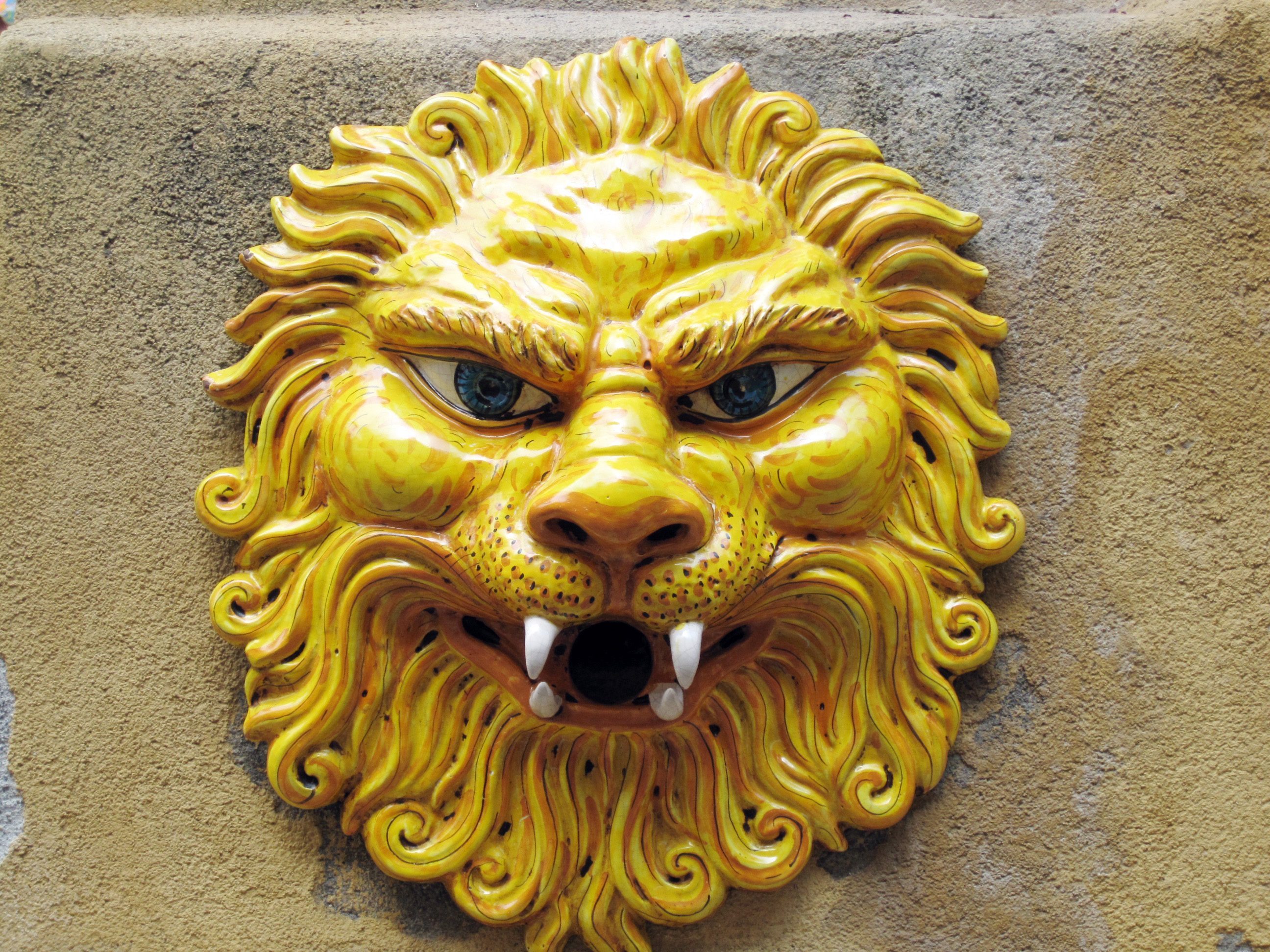 Ah Sicilia; home the gods, a melting pot of civilizations, warm hospitality, amazing food and wine and really bad drivers.
Ah Sicilia; home the gods, a melting pot of civilizations, warm hospitality, amazing food and wine and really bad drivers.
Homer referred to Sicily as Thrinakia in the Odyssey. This was where Odysseus’ crew ate some of the sacred cattle that belonged to the god Helios (a very bad idea). It is also the island of the Polyphemus, the Cyclops and the water hazards of Scylla and Charybdus. This is the land where Zeus, Apollo and Athena and a few other gods were born. It’s where Hades abducted Persephone (Kore) to his underworld. And yet with all of this mythological splendor, it has one of the saddest histories in all of Italy.
Today, the large rocks that Polyphemus the Cyclops threw at Odysseus and his crew still lie off the coast near Giardini Naxos. The strong currents and wrecking reefs in of Scylla and Charybdus in the straits of Messina were destroyed by massive earthquakes, volcanic eruptions and tidal changes. The spring of where the nymph Arethusa emerged after diving into a river in Greece to escape the clutches of the river god Alpheus is now a beautiful fountain and tourist destination in Siracusa. The sickle that Zeus slayed his father with is now the bay of Trapani. The mythology goes on for many pages.
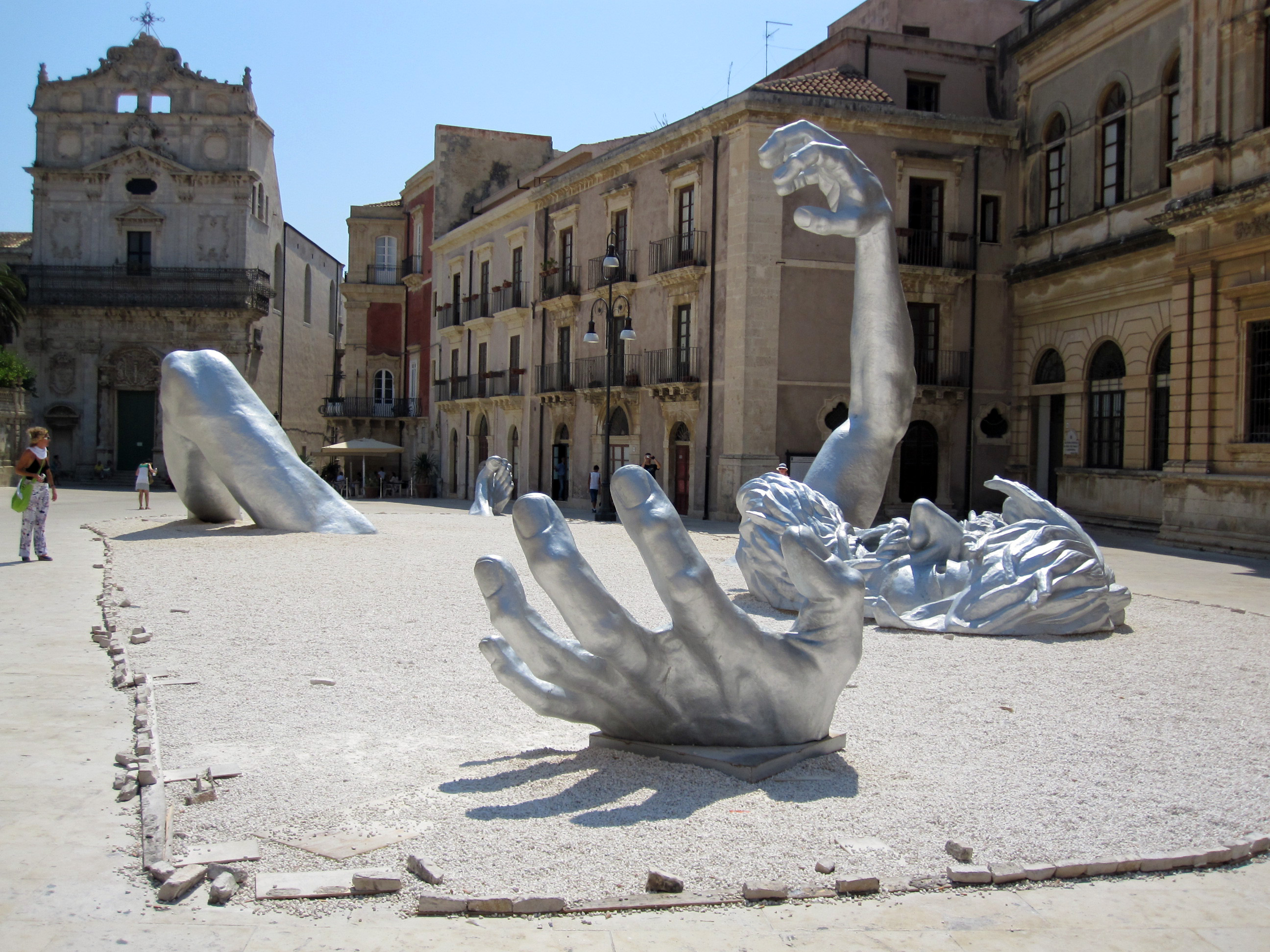 Siracusa (Syracuse)
Siracusa (Syracuse)
During the expansion of Greece in the 8th century BCE, southern Italy and Sicily was known as Magna Grecia, with Siracusa (Syracuse) as it’s largest city. There are still a few ancient Greek sites on the Italian mainland, but the best preserved remains of ancient Greece are here in Sicily.
During the height of it’s former grandeur, Siracusa (Syracuse) had a population close to 300,000. For a time it rivaled Athens as the most important city of the ancient world. At one point it even defeated Athens in a long hard fought war won by the tyrant Dionysius the Elder. One of the most famous stories about him is when his advisor Damocles tried to get in his good favor by complimenting the tyrant on how fortunate he was to have accumulated all his power and wealth, Dionysius sat Damocles down in his throne and suspended a dagger over his head, point down, hanging by one horse hair, asking him, “now how do you think it feels to be the tyrant?” By the way, Dionysius the elder was eventually poisoned by his doctors. I guess he wasn’t so fortunate after-all.
The oldest settlement of Siracusa (Syracuse) is on the island Ortygia, (from the Greek for “quail,” probably because the birds were abundant in the area. This was the city of Archimedes (the Leonardo Da Vinci of his day) and the playwrights Pindar and Aeschylus. It’s often described as the New York City” of ancient Greece.
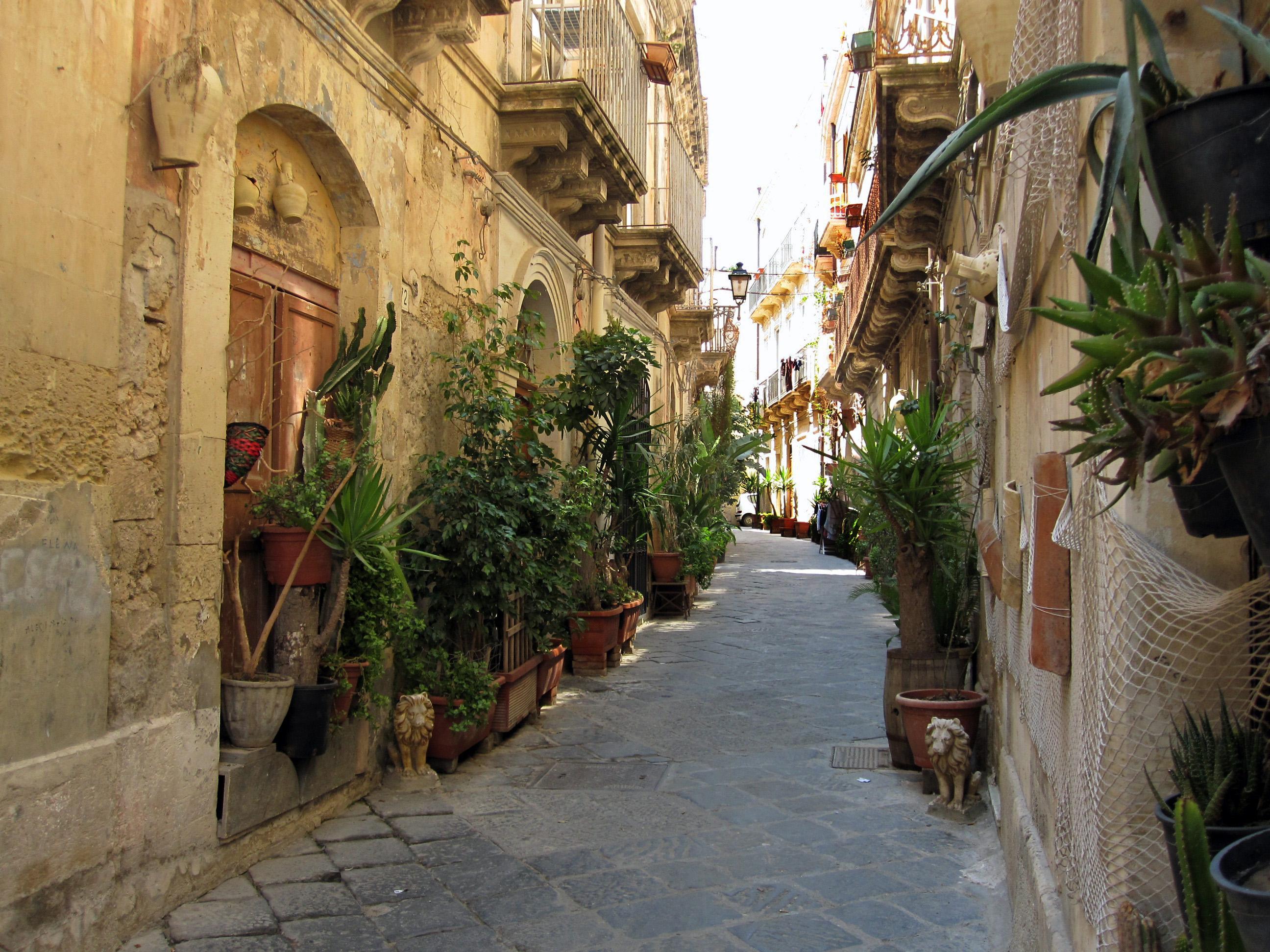 When we were last here (2003), the Ortygia still had it’s charm but it was pretty run down and covered with 300 years of dirt and graffiti. The city was destroyed in 1693 by the Volcanic eruption that wiped out most of the east coast of the island. It was rebuilt with glorious yellow sandstone Baroque buildings but the last time they looked this good was probably in the early 18th century. The city has been going through a wonderful facelift. Buildings have been cleaned, streets have been paved and business is booming. The renovation that started around 2004 is very close to being done. The Ortygia is once again full of life, filled with wonderful restaurants, boutique shops, cafes, and no graffiti. In fact the walls of most of southern Sicily are clean. The Sicilians had enough of the problem and they are now very vigilant. I’m sure the fine is enormous. I wish the rest of Italy would follow this example.
When we were last here (2003), the Ortygia still had it’s charm but it was pretty run down and covered with 300 years of dirt and graffiti. The city was destroyed in 1693 by the Volcanic eruption that wiped out most of the east coast of the island. It was rebuilt with glorious yellow sandstone Baroque buildings but the last time they looked this good was probably in the early 18th century. The city has been going through a wonderful facelift. Buildings have been cleaned, streets have been paved and business is booming. The renovation that started around 2004 is very close to being done. The Ortygia is once again full of life, filled with wonderful restaurants, boutique shops, cafes, and no graffiti. In fact the walls of most of southern Sicily are clean. The Sicilians had enough of the problem and they are now very vigilant. I’m sure the fine is enormous. I wish the rest of Italy would follow this example.
We booked a room for 3 days at the Hotel Cavalieri on Via Malta, three blocks from one of the Ortygia pedestrian bridges. We chose this hotel because although we wanted to be close to the Ortygia we wanted to be a little bit away just in case it got too noisy. We couldn’t have been happier. This is a luxurious 4star family run hotel owned and operated by Gianluca Lo Manto and his family (mother, sister, wife). Gianluca is also the architect . The rooms are quiet, very good size and mix of contemporary design with a few of the families historical furnishings. The staff is incredibly friendly and extremely attentive to your every desire.
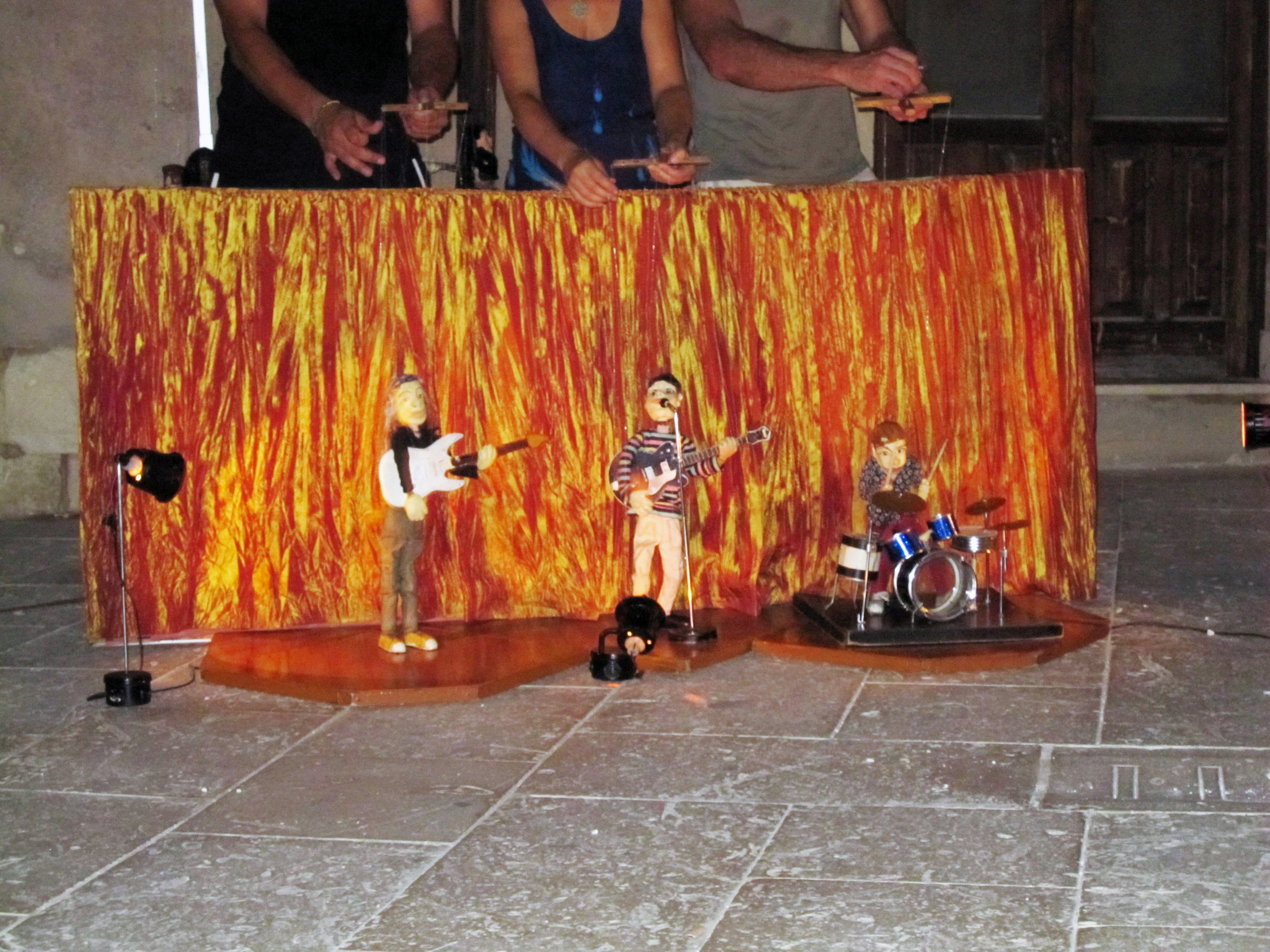 There was a festa (celebration) on our first night in the Ortygia and the streets were filled with people. Live music was everywhere, and not the typical annoying Italian accordion players. We had an excellent jazz band in one Piazza, marionette versions of Credence Clearwater Revival and Bob Marley and the Wailers in the Duomo Piazza, a Jazz band with handmade instruments in another Piazza and the grand finale was a giant explosion of fireworks. What a welcome to Siracusa. As we walked back to our hotel at around midnight, there were still families of elderly grandparents and small children walking across the bridges into the Ortygia.
There was a festa (celebration) on our first night in the Ortygia and the streets were filled with people. Live music was everywhere, and not the typical annoying Italian accordion players. We had an excellent jazz band in one Piazza, marionette versions of Credence Clearwater Revival and Bob Marley and the Wailers in the Duomo Piazza, a Jazz band with handmade instruments in another Piazza and the grand finale was a giant explosion of fireworks. What a welcome to Siracusa. As we walked back to our hotel at around midnight, there were still families of elderly grandparents and small children walking across the bridges into the Ortygia.
Marionettes are popular in Sicily but the main puppet tradition here is for the +3′ tall puppets of the Teatre di Pupi (Puppet theatre). This artform goes back to the Normands in the 11th century. Most of the plays surround the “Song of Roland” (Orlando in Italian), the 11th century knight who fought the Muslim invasion of western Europe.
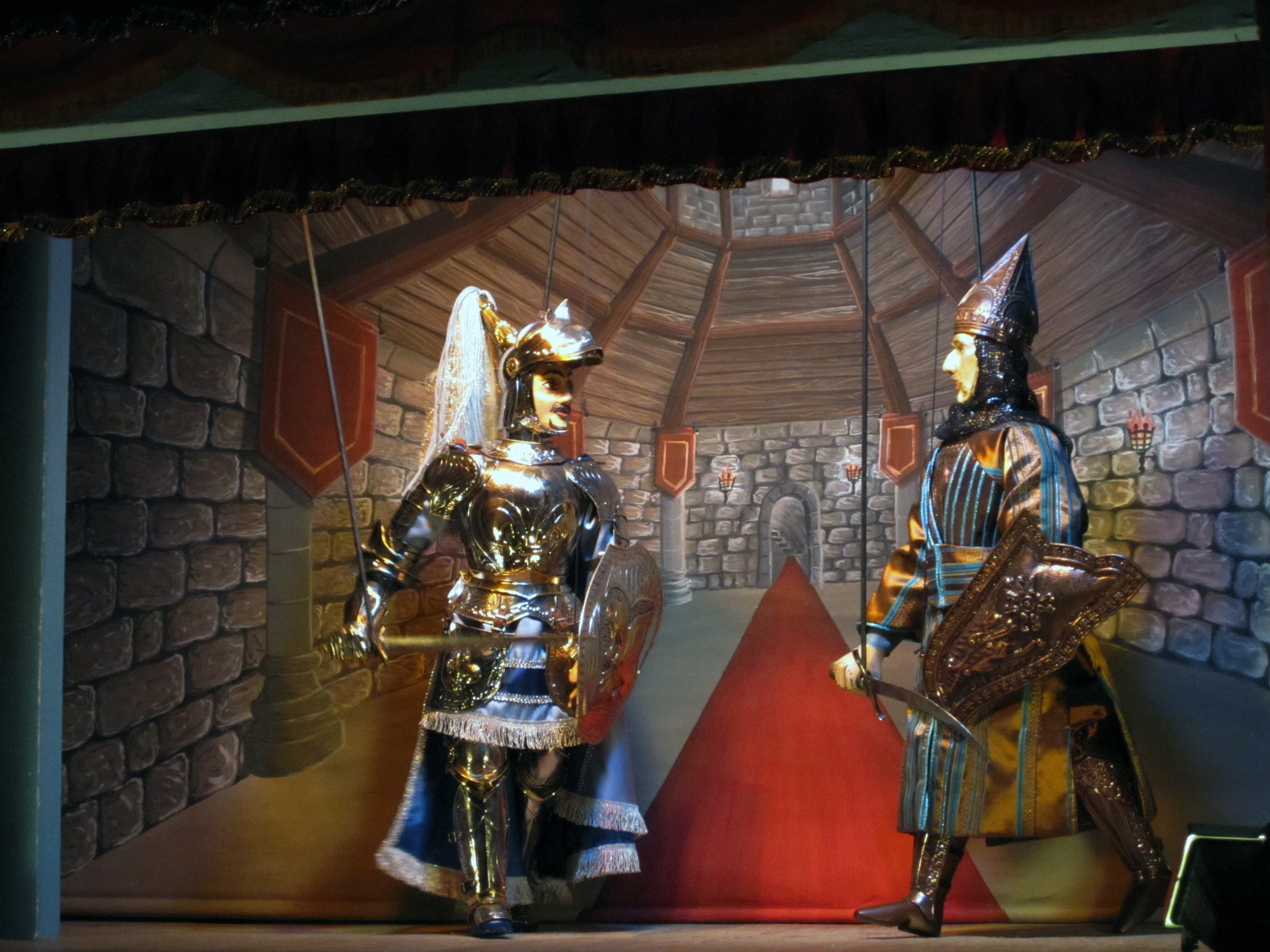 The story is performed in episodes, or cliff hangers. Each performance is 1hr long and costs €4. You have to come back every night to find out what happens nest. In our episode, the Muslim leader Agricane is storming the Castel of Sacripante the King of Cirassia. Before the battle though we are led through a love rivalry, a doomed meeting with An evil sorceress, a bewitched giant and finally the battle scene.
The story is performed in episodes, or cliff hangers. Each performance is 1hr long and costs €4. You have to come back every night to find out what happens nest. In our episode, the Muslim leader Agricane is storming the Castel of Sacripante the King of Cirassia. Before the battle though we are led through a love rivalry, a doomed meeting with An evil sorceress, a bewitched giant and finally the battle scene.
The plays have lots of action. Within 5 minutes there is a sword fight. At the end of the our performance there were at least 10 puppet corpses piled up on the stage, some of them beheaded. King Sacripante is killed, our hero, the Paladin knight Duke Astolfo, is badly wounded, the Castle is torched by Agrican’s army and Queen Angelica flees to Paris. And yes, this is a puppet show..
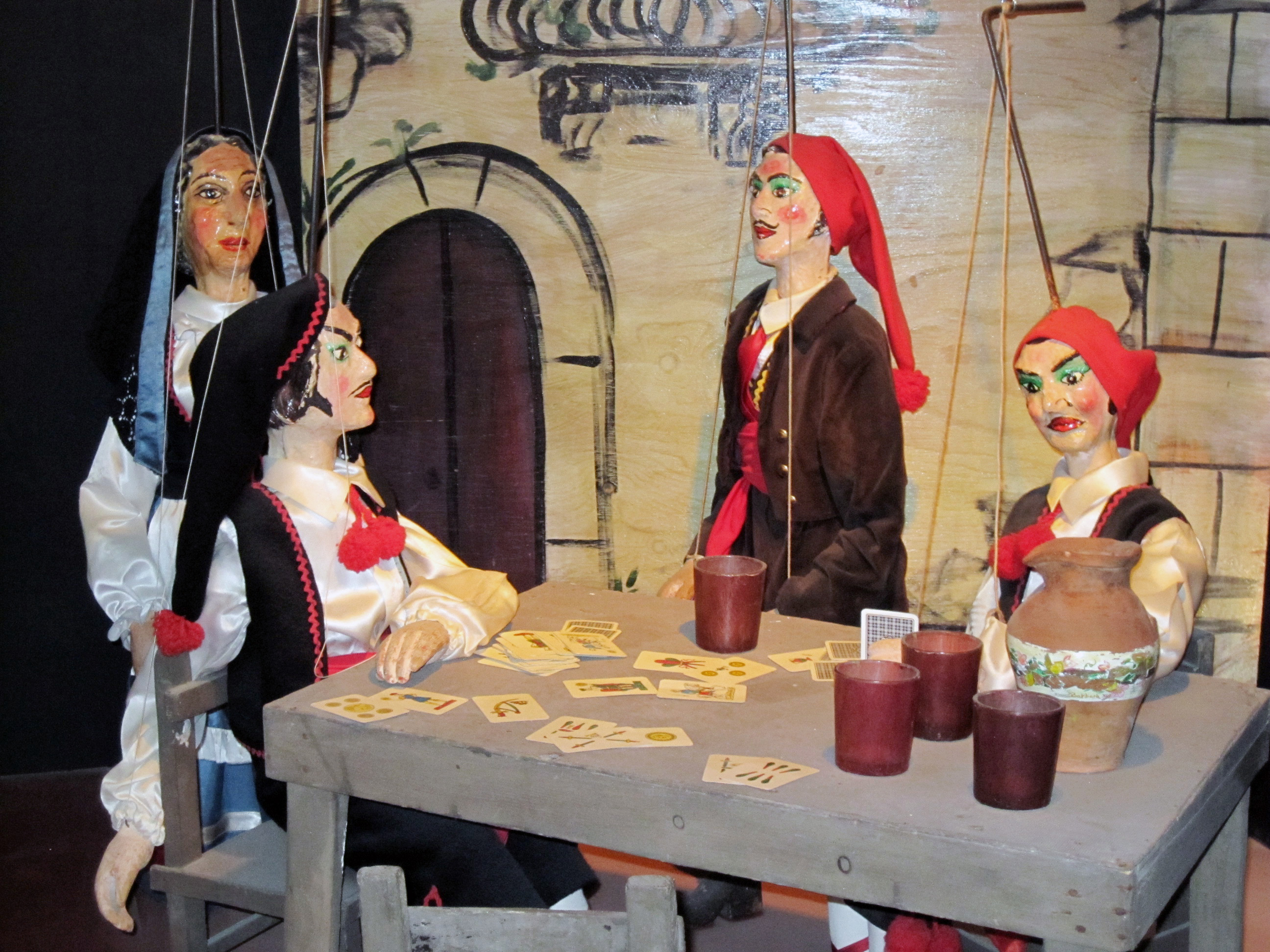 Alfredo and Rosario Vaccarro brought the Pupi tradition back to Siracusa in the 1960’s. Their performances were so popular that in 1983, they built puppets to stage the opera of Cavaliere Rusticana. The puppets were built and the scenery was painted, but the Opera society wanted too much money for royalties. The show sits in the puppet museum along side the Pinocchio puppets. Disney Studios also wanted too much money in royalties for the Vaccarro brothers to perform that one as well.
Alfredo and Rosario Vaccarro brought the Pupi tradition back to Siracusa in the 1960’s. Their performances were so popular that in 1983, they built puppets to stage the opera of Cavaliere Rusticana. The puppets were built and the scenery was painted, but the Opera society wanted too much money for royalties. The show sits in the puppet museum along side the Pinocchio puppets. Disney Studios also wanted too much money in royalties for the Vaccarro brothers to perform that one as well.
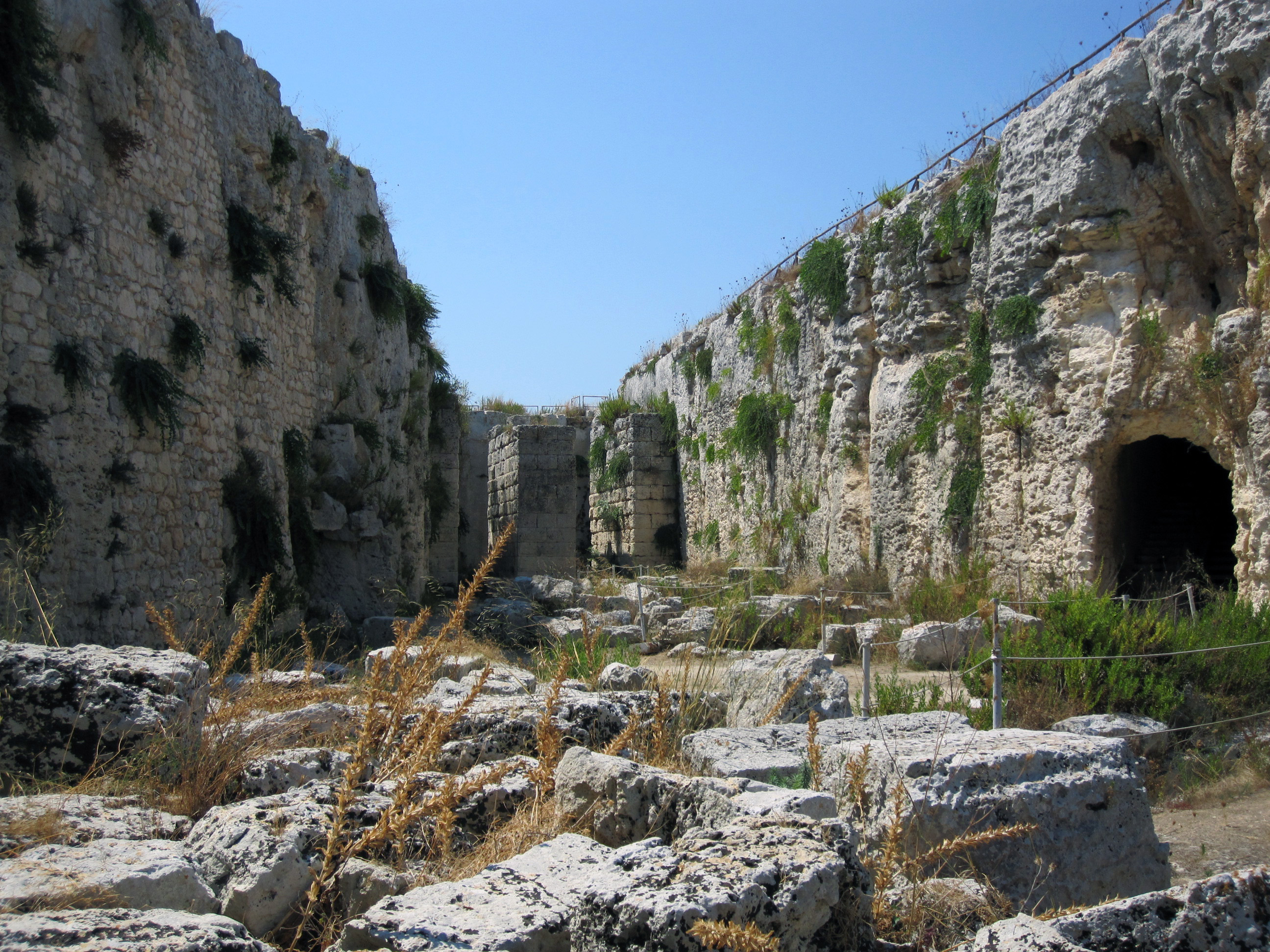 About 9km from the Ortygia is the Castello Eurialo (e your ya lo) , the stronghold of the defense of ancient Siracusa. The Athenians actually started it as a mountain wall to the keep the Siracusans from getting supplies outside of the city. The Siracusans had walled off the harbor so the Athenians couldn’t get in. After Siracusa won the war, Dionysius decided to finish the wall as a northern defense of the region. In just 5 years, from 402 BC to 397 BC he completed the immense castle and 27 kilometers of the wall, a pretty amazing project in any era.
About 9km from the Ortygia is the Castello Eurialo (e your ya lo) , the stronghold of the defense of ancient Siracusa. The Athenians actually started it as a mountain wall to the keep the Siracusans from getting supplies outside of the city. The Siracusans had walled off the harbor so the Athenians couldn’t get in. After Siracusa won the war, Dionysius decided to finish the wall as a northern defense of the region. In just 5 years, from 402 BC to 397 BC he completed the immense castle and 27 kilometers of the wall, a pretty amazing project in any era.
 The Castle still has an (intact) underground system of large tunnels where the war machines (designed by Archimedes) were moved from one side of the castle to the other. The fortress was impregnable and only fell once (without a battle).
The Castle still has an (intact) underground system of large tunnels where the war machines (designed by Archimedes) were moved from one side of the castle to the other. The fortress was impregnable and only fell once (without a battle).
In 212 BCE, while the guards of walls left their posts to enjoy the Festival of Aphrodite, the troops of the Roman Marcellus, walked right in.
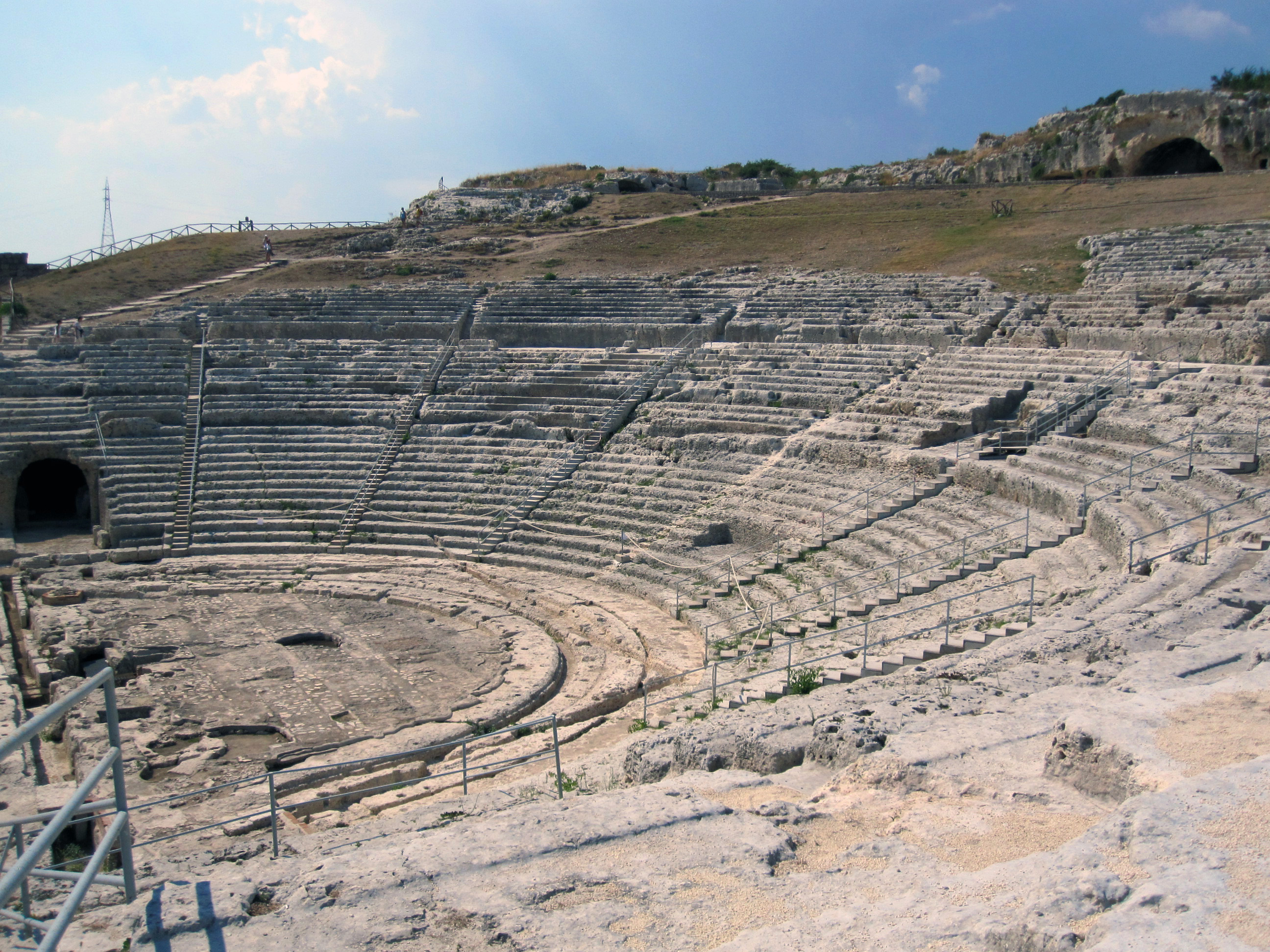 About a 20 minute walk from the Ortygia is the Archeological Park with the Greek Theatre (one of the largest in known history). It’s 455’ in diameter and could seat 15,000 people. It’s still used today and yes, it still shows ancient Greek plays for all you Aeschylus fans.
About a 20 minute walk from the Ortygia is the Archeological Park with the Greek Theatre (one of the largest in known history). It’s 455’ in diameter and could seat 15,000 people. It’s still used today and yes, it still shows ancient Greek plays for all you Aeschylus fans.
Next to the theatre is a Roman amphitheatre built in the 3rd century AD. It’s also one of the largest Roman Amphitheatres in the world.
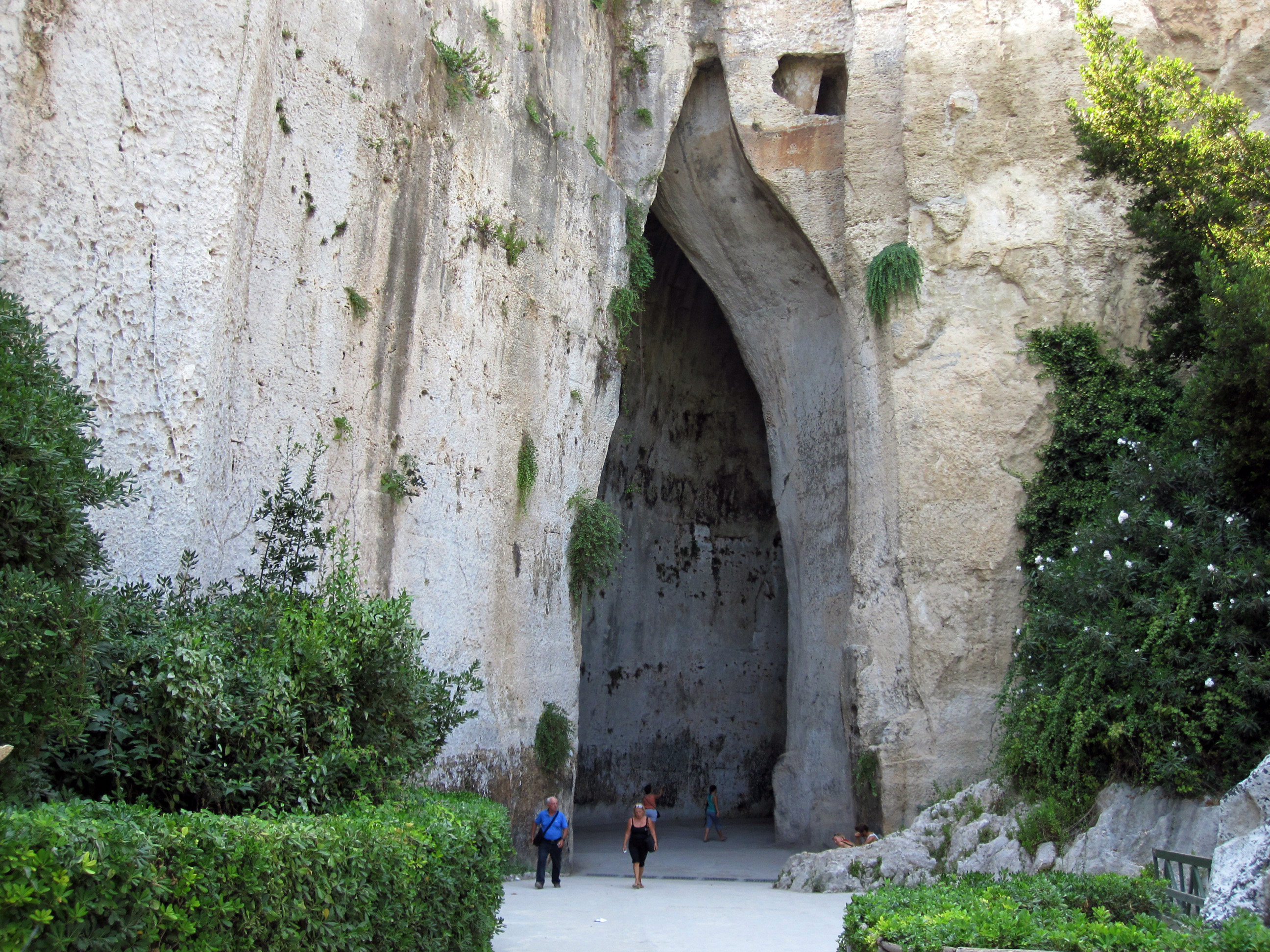 The strangest item in this archeological park is known as the “Ear of Dionysius”. This manmade cave (211’ long by 69’ high) was given it’s name in the 17th century by the artist Caravaggio because of the shape of the cavern entrance (it does look like an ear).
The strangest item in this archeological park is known as the “Ear of Dionysius”. This manmade cave (211’ long by 69’ high) was given it’s name in the 17th century by the artist Caravaggio because of the shape of the cavern entrance (it does look like an ear).
The acoustics inside are a wonder in itself, as attested by every visitor who enters the cave. One of the stories surrounding it’s origin is that Dionysius put his political prisoners in here so he could listen to their secrets, but no one really knows what the cave is for. It’s just there and it looks great.
Nearby the Archeological Park is the Archeology Museum (a great collection of pottery shards and votive statues). It seems to be a museum in progress. It’s a beautiful building and supposedly has one of the best collections of ancient Sicilian art but after a few rooms of broken pottery shards and a few hundred votive stature of Kore (Persephone) you get kind of ready to move on. There are some great photos of the digs and locations of all of the ancient cities and some good archeological explanations but the museum is very confusing.
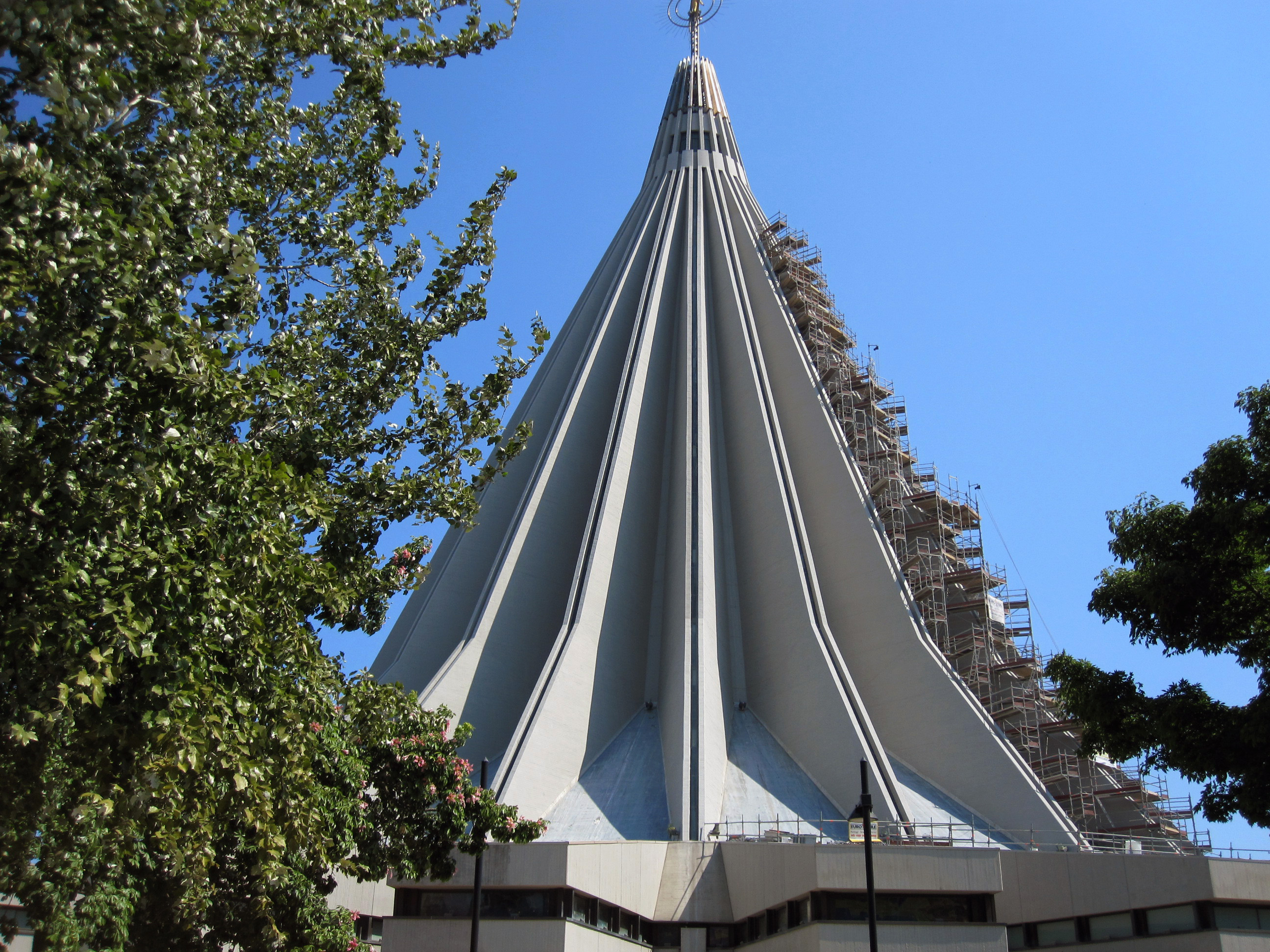 Across the street from the museum, built directly over the remains of the ancient temples to Demeter and Kore/Persephone, Sicily’s oldest goddesses, is the church to Sicily’s newest phenomenon, Basilica Santuario Madonna delle Lacrime. It’s is a bizarre looking church. The spire looks like an upside down ice cream cone. The story behind the church is even stranger.
Across the street from the museum, built directly over the remains of the ancient temples to Demeter and Kore/Persephone, Sicily’s oldest goddesses, is the church to Sicily’s newest phenomenon, Basilica Santuario Madonna delle Lacrime. It’s is a bizarre looking church. The spire looks like an upside down ice cream cone. The story behind the church is even stranger.
From August 29 to September 1, 1953, a small plaster plaque of the Virgin Mary allegedly shed real human tears in Syracuse. The 29 x 22 cm plaster plaque of the Immaculate Heart of Mary was a copy of a copy from a copyist’s studio in Tuscany. It was given to Antonina and Angelo Iannuso as a wedding gift. Angelo hung the plaque on the wall behind their bed.
On the morning of Saturday, August 29, 1953, Antonina noticed that the image was weeping. Within hours the entire neighborhood heard about the “miracle”. Of course, this was the 1950’s and they couldn’t just declare it a miracle so they called in the neighborhood Doctor and Pharmacist to pass judgment. The Doctor suggested to call in a group of specialist to examine the tears. The Pharmacist using his most advanced scientific training, lifted some of the moisture from the plaque with his finger and stuck it into his mouth. “It is human tears” he declared and the miracle was substantiated.
On the 3rd day of the miracle, a scientific team did finally show up and took samples. According their research the substance did prove to be the same composition as human tears. Of course it’s also the same composition of moisture mixed with the plaster or paint of the cheap copy of the statue. By hey, any excuse to build a miracle. They couldn’t just put the magic plaque in any church. It required it’s own, which now sits across the street from the Archeological Museum.
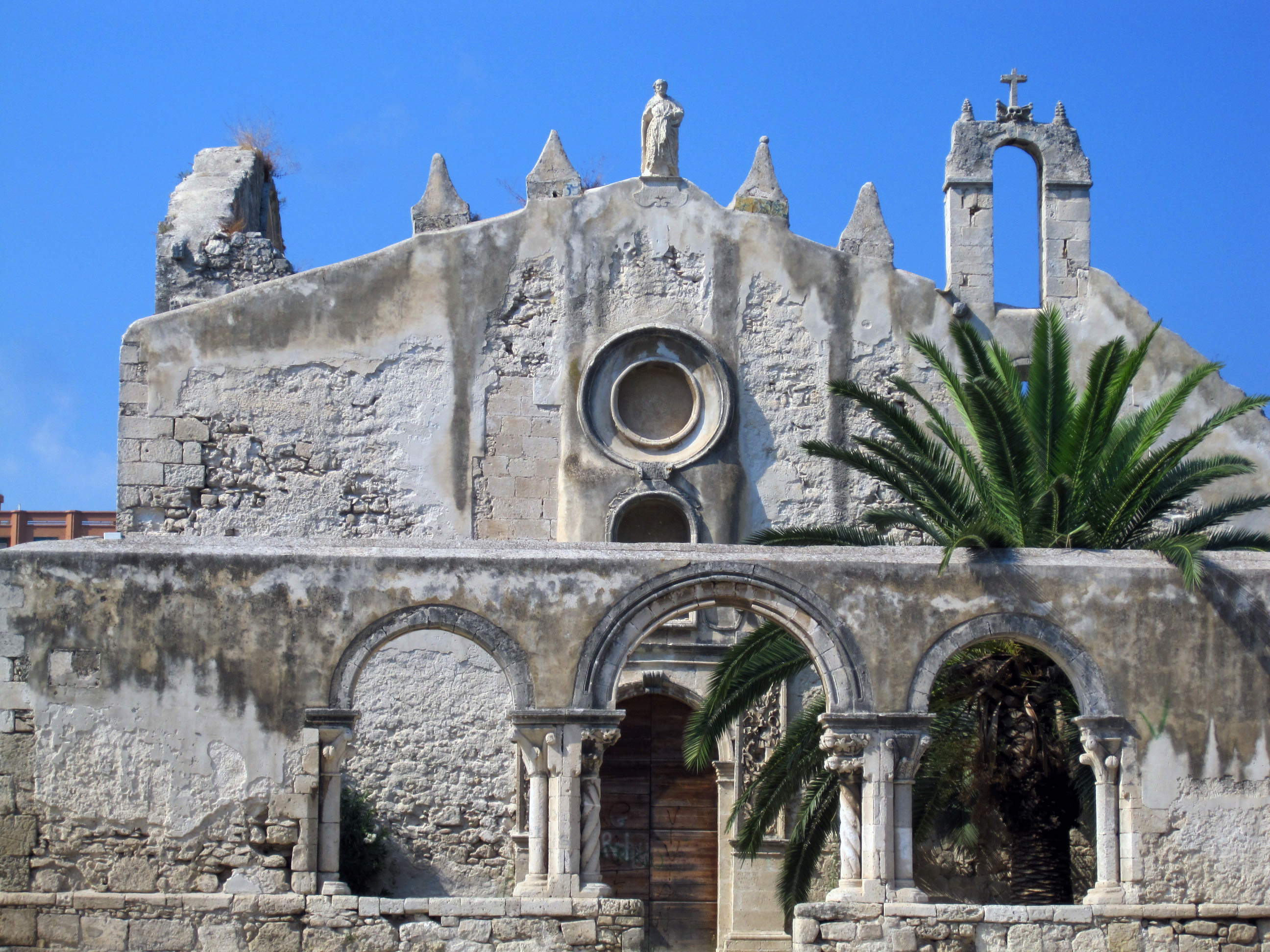 Near the very modern Basilica Santuario Madonna delle Lacrime, sits the remains of the Church of San Giovanni.The is a facade more to my liking.
Near the very modern Basilica Santuario Madonna delle Lacrime, sits the remains of the Church of San Giovanni.The is a facade more to my liking.
San Giovanni was destroyed in the 1693 earthquake and was never rebuilt. However the facade had long stood as a reminder of what was once here. Under the San Giovanni Church is a 6th century catacombs. It was closed on the day we were there. Even bones need a day off.
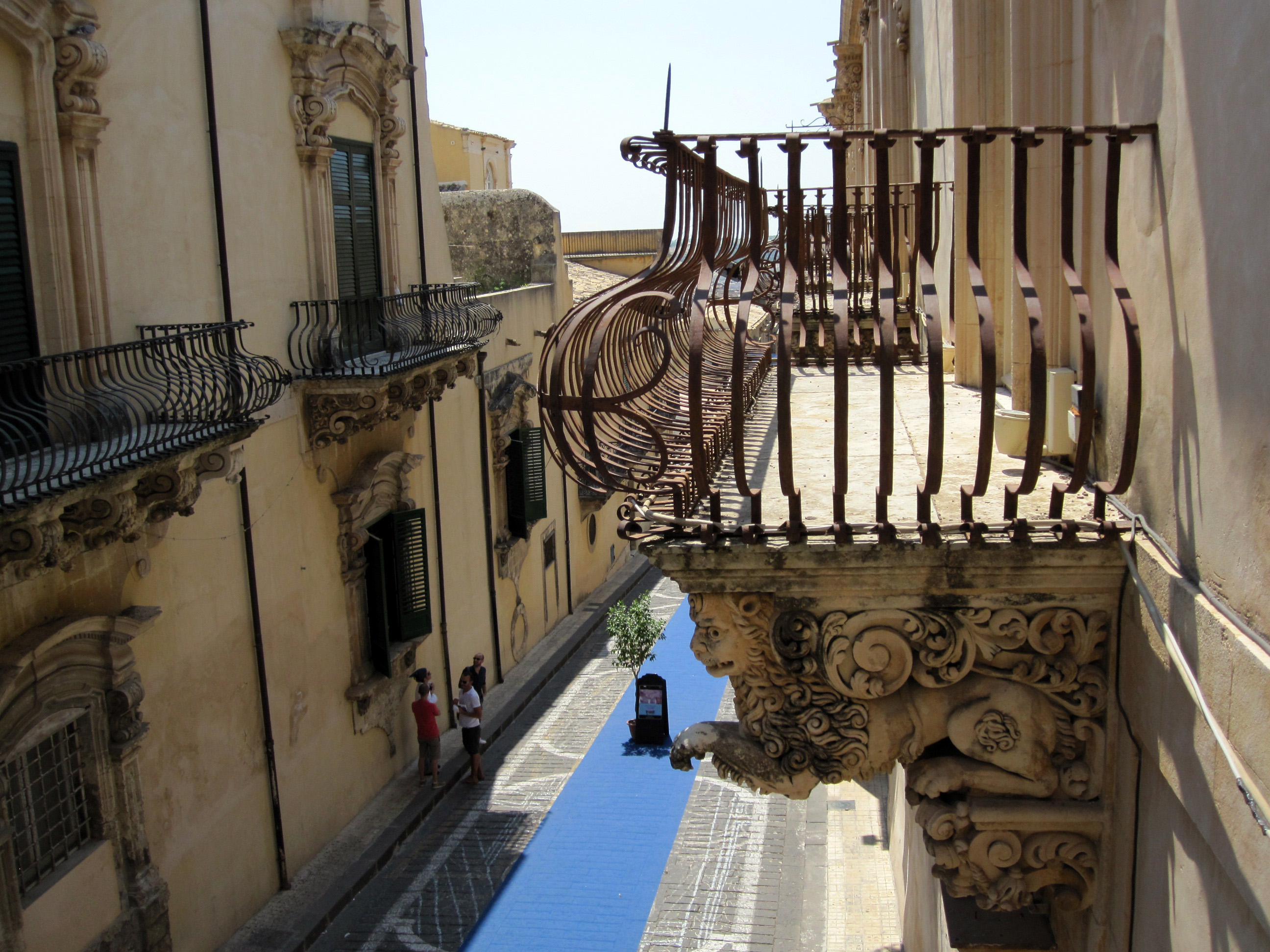 NOTO
NOTO
Noto was also destroyed in the 1693 earthquake. Instead of rebuilding the old town, the residents and town planners decided to build a new town a few kilometers away and start all over again. The location was beautiful and the beautiful Sicilian Baroque buildings of yellow sandstone glowed in the sun like ancient Egyptian temples.
The town soon received the nickname “Garden of Stone”. There are wide streets with magnificent baroque buildings decked out in curved wrought iron balconies. Baroque buildings were the style of Italy in the 17th and 18th century. Rome is filled with them but in Sicily, the only stone available was sandstone and consequently the Sicilian Baroque has a completely different and simpler appeal. It is simple and yet elegant. It fits perfectly with this part of the world.
The town planners might have thought this was the perfect location when they built the new Noto at the beginning of the 18th century, but during a structural inspection of the town in 1986, they discovered that their magnificent location was actually built along the most dangerous part of an earthquake fault line. The slightest tremor could bring the whole town down in minutes. What a decision to make; evacuate or stay. The nunnery was evacuated as well as other parts of town, but the brave residents decided to keep their precious city and rebuild the foundations of the buildings. They’ve been doing it for the past 20 years. Unfortunately, they didn’t finish the restructure of the The Cathedral of San Nicolo (also called Corrado Gonfalconiere) in time. In 1996 the interior of the Cathedral of St Nicolo collapsed. It was devastating to the town.
In 2007 the church open up again but the entire 18th century interior is gone and has been replaced with a very simple white decor. Sicilian Baroque is also referred to as Earthquake Baroque. Earthquakes and Volcanic eruptions are a way of life here. Sicilians accept them they way we accept earthquakes in San Francisco. You hope they don’t happen but you’re pretty sure they will eventually.
Noto is a good 2-3 hour visit and it’s only about 20 minutes from Siracusa. When you’re there, treat yourself to a granita and cassertine (a delicious small pastry filled with almond crème) at Café Costanza on Via S. Spaventa. the cafe very close to the Cathedral. We suggest the mandarino granita. It is unbelievable. So is the cassertine.
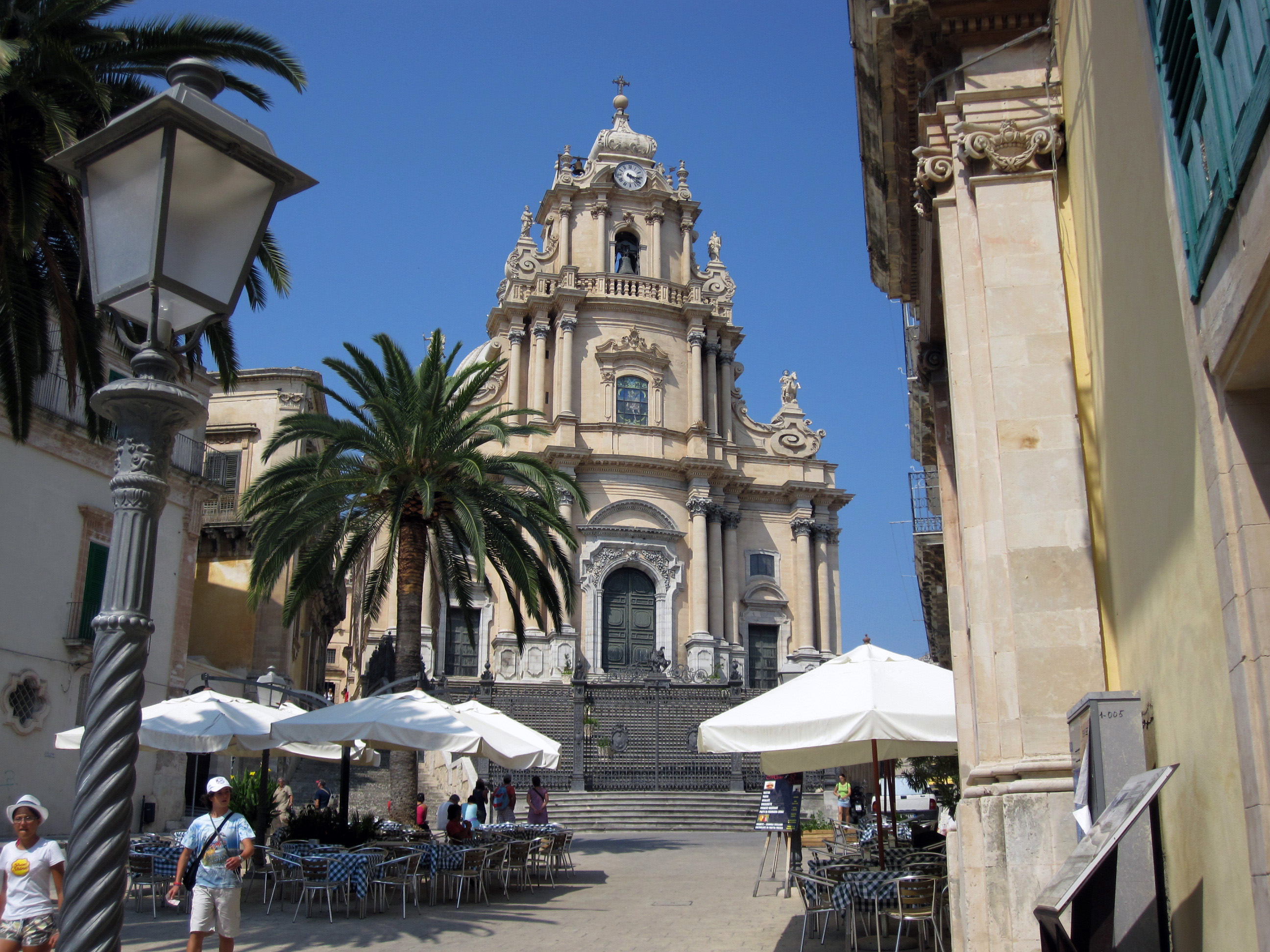 RAGUSA
RAGUSA
Ragusa is actually two towns, Ragusa Superiore (the new more modern city) and Ragusa Ibla (the old town). They used to be rival cities, but in 1926 they were combined into one. Now they have to just get along.
We went to see the Sicilian Baroque of Ragusa Ibla. Ibla was originally settled by the pre Greek inhabitants of the island, the Sikels. It’s mountain location was ideal as a fortified military position but apparently not too good. It was conquered by the Greeks, Romans, Moors, Normands and finally by the eruption of Mt Etna in 1693. When the residents rebuilt the city they kept the web of old winding streets and alleys. Let’s just say you need a map.
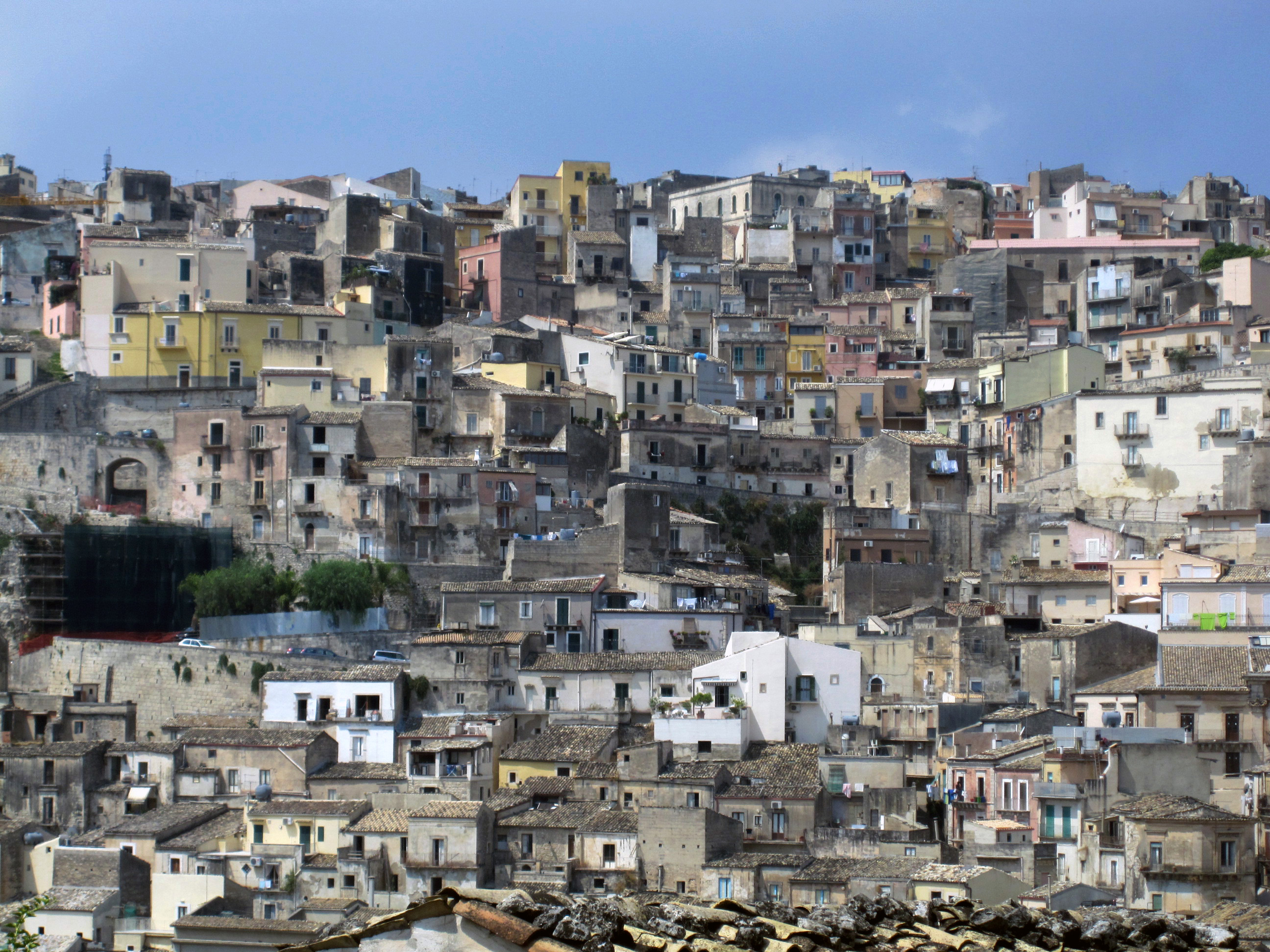 There are some beautiful views, grand Piazzas, a very peaceful park and in the main Piazza Pola we found the Gelati di Vini, a gelateria that makes gelato with wine. We tried to nero d’avalo and the moscato grape gelato. They were pretty amazing.
There are some beautiful views, grand Piazzas, a very peaceful park and in the main Piazza Pola we found the Gelati di Vini, a gelateria that makes gelato with wine. We tried to nero d’avalo and the moscato grape gelato. They were pretty amazing.
After climbing in the hills of Ragusa, we drove down to the Medierranean sun baked terracotta rooftops of Marina di Ragusa.
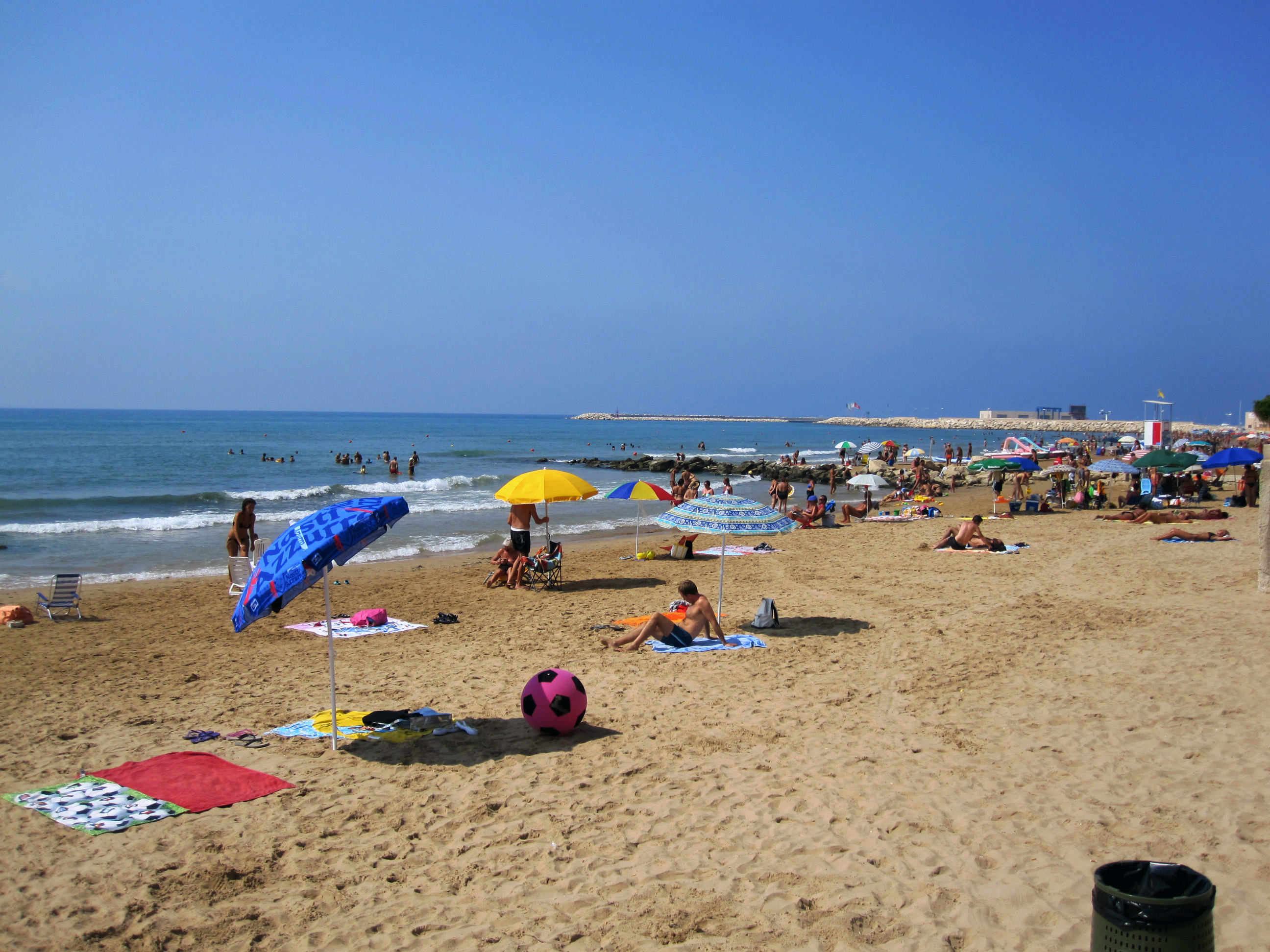 This is a typical beach town with bars, gelateria, cafes, beachwear shops, restaurants and hundreds of people walking the streets in swimsuits carrying lounge chairs and beach paraphernalia. The town looked so good in the daylight we came back that night for a seafood dinner of tuna caponata, stuffed clams, marinated sardines, smoked fish and an Orata (same as the Dorado fish of France) baked in salt.
This is a typical beach town with bars, gelateria, cafes, beachwear shops, restaurants and hundreds of people walking the streets in swimsuits carrying lounge chairs and beach paraphernalia. The town looked so good in the daylight we came back that night for a seafood dinner of tuna caponata, stuffed clams, marinated sardines, smoked fish and an Orata (same as the Dorado fish of France) baked in salt.
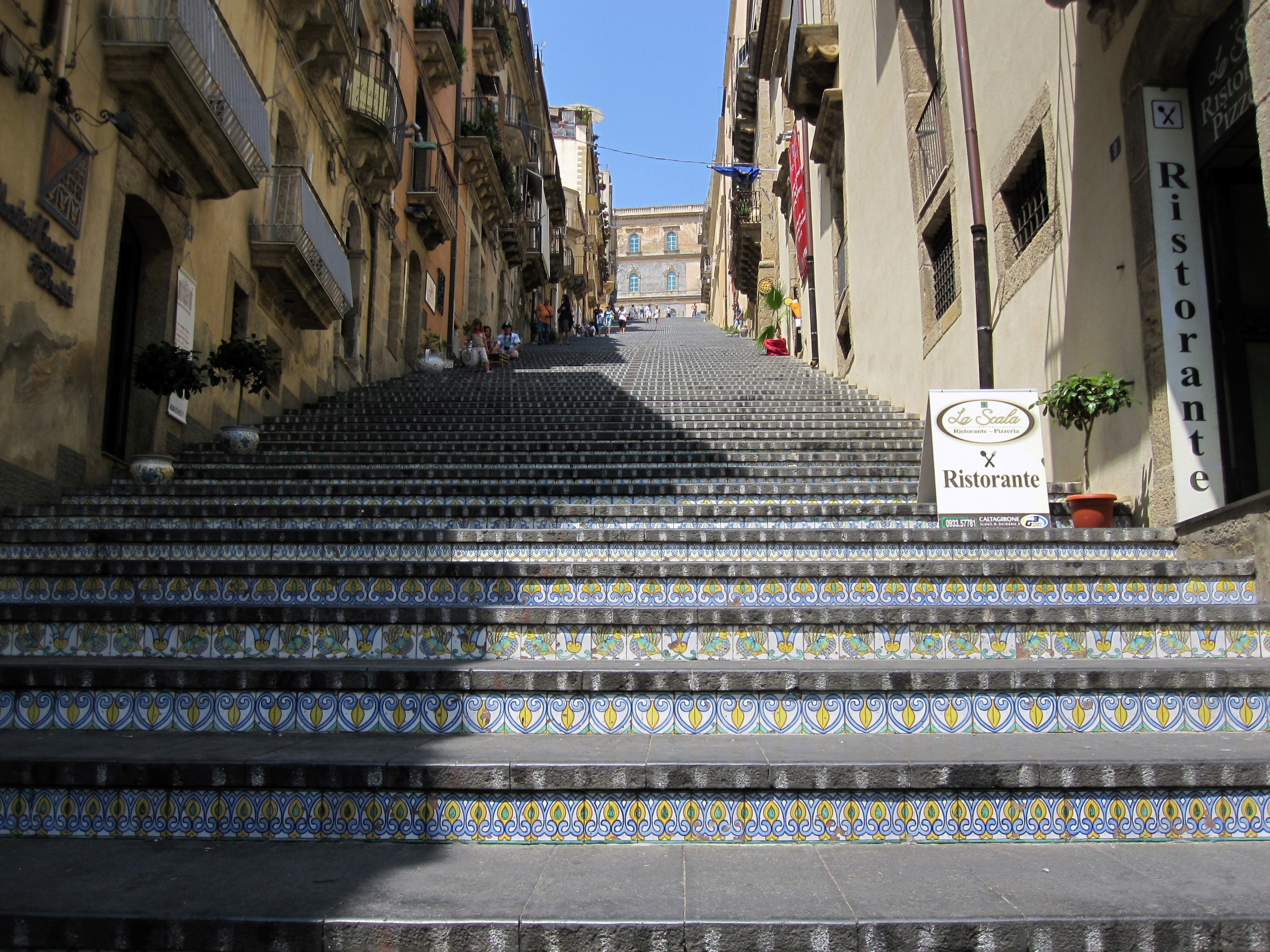 CALTAGIRONE
CALTAGIRONE
We’re making the pilgrimage to the small city of Caltagirone, the ceramic capital of Sicily. We’ve seen these ceramics all over the island and although we’re not big fans of the style, we decided to go and see where they all come from.
It’s truly unbelievable how many ceramic shops there are in Sicily and all most of it seems to be made in this one small town up about 2000 feet up in the Iblean mountains. But even the location up this high didn’t save it from the 1693 earthquake. Yes, this town was rebuilt as well. The earthquake of January 11, 1693 destroyed at least 45 towns, villages and cities. Over 5600 square kilometers were rocked and the damage extended down to the island of Malta. Over 60,000 people died from the quake. It could be the worst natural disaster known to the western world.
Aside from the ceramic museums and ceramic nativity shops and just plain old shops selling any kind of ceramics, there is the very famous Scala di Santa Maria del Monte. This is a 142 step staircase with all the step faces decorated in ceramics. It was rebuilt in 1953. It’s a tough climb if your not in good shape. It’s not just a step up. The treads are very wide, probably so people wouldn’t fall down them, and consequently you step up and then walk 2 steps in before stepping up again. It sounds like it should be easier, but it’s not. But don’t worry. If you get tired from the climb there are ceramic shops waiting for you on almost every step.
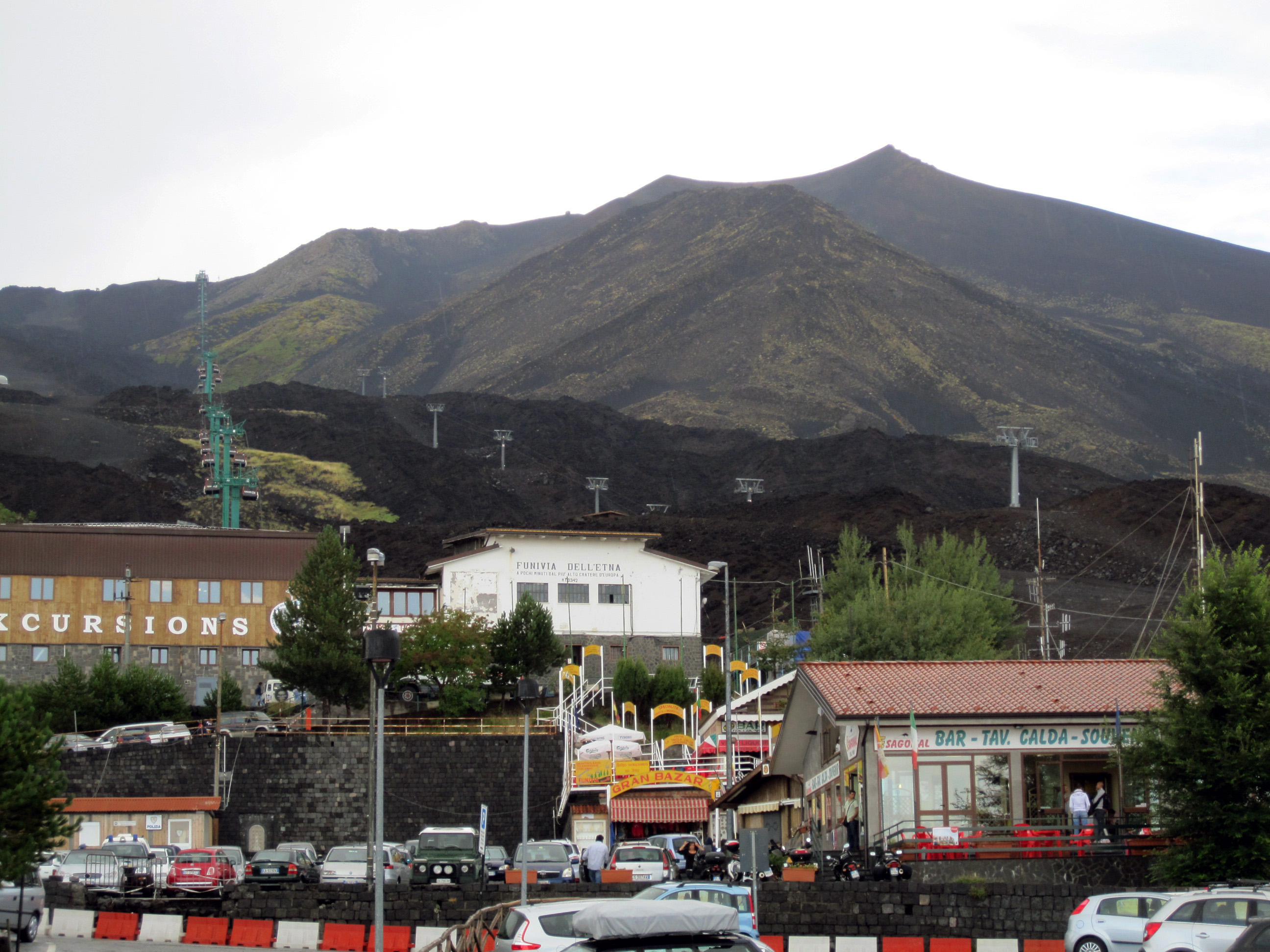 MT. ETNA
MT. ETNA
Etna in ancient Greek mean “I burn”. This is the largest active volcano in Europe. There are several smaller craters in the Volcanic range, but the big guy towers over all of them at around 3,350 meters tall (11,000 feet). This is the one true god of Sicily. The locals refer to Etna as a good Volcano because the crater is so far away from the homes that when it does erupt, the lava takes a long time to get down the hill and the residential areas can be saved by rerouting the lava flow or cooling it with water. We we asked what is a bad Volcano, they replied Vesuvius. When it errupts it destorys everything very fast.
There are lots of ancient tales of the big Volcano, but my favorite is about the philosopher Empedocles of ancient Agrakas (now Agrigento). Empedocles (490BCE-430BCE) was the philosopher who created the theory of the four elements (Earth, Air, Fire and Water). He also had a theory that heavy atmosphere was corporeal and not just vapor.
As the legend goes, in order to prove his point he jumped into the Etna volcano thinking the corporeal vapor would lift him back up. It didn’t. Supposedly the only thing the Volcano did throw back was one of his sandals.
The typical way up to the top is to drive to Refugio Sapienza at 1,923m (6,634 feet) up the mountain. It was 34° when we left the beach of Acrireale. It dropped to 14° when we arrived to the Refugio Sapienza.
The top of the Volcano is close to 11,000 feet above sea level. It makes it’s own weather up here. You can drive as far as the base camp of Refugio Sapienza. This area is operated by the Sicilian Alpine Club but it also houses a small village of bars, restaurants and souvenir shops. From Sapienza you have the choice to take the Funavia (cable car) up to the height of 2,500m (8,250 feet). From there you get into a 4Weel drive vehicle up to 2,900m (9,570 feet). The rest of the way up is on foot under the care and guidance of the Alpine patrol.
It was a beautiful sunny day when we started our upward ascent to the Rifugio Sapienza, by the time were got there, there was a thunder and lighting rain storm. It was very god like and we had nothing to appease the gods except euros. The cost of the ticket to the top is a whopping €52 per person. In today’s wimpy dollars, that would be about $156 to take a cable car ride, a jeep ride and a 40 minute walk up to a live crater. It was pretty pricey, but we were committed to making the climb. The only problem was the cable car was closed due to inclement weather. They didn’t know when they’d reopen. We waited a while and strolled through the endless souvenir shops. The weather pattern didn’t move and so we did.
Driving down the mountain we passed by a lot of locals setting up their picnic tables next to man made heaps of garbage. I guess it’s a short throw to get rid of the garbage when your done eating. A few kilometers down the mountain we ran into a Mt Etna car rally. There were at least 30 cars all tagged with sponsors getting ready to hit the small streets that wind around the crater. I got to see my first ever Fiat 127. It sounded like an old lawnmower we had when I was a kid.
The car rally blocked the main road down the mountain and for a few minutes we were wondering if we were going to get a sponsor and join the show. But instead, one of the locals gave us directions on how to get down and out. At this point we were close enough to Catania to say “why not?”
 CATANIA
CATANIA
Catania is one of the saddest city in Sicily. The city has been built over 7 times, mostly after eathquakes and Volcanic eruptions. Etna has a serious problem with Catania.
Where most of the Sicilian Baroque buildings in other parts of Sicily have been cleaned up, not so much here. Either the historical society said ‘forget it” or they gave the money to someone in the Catania urban renewal department and it just disappeared. Catania does seem to have more crime than any other place in Sicilia and we were told many times to be very careful if we went there. But being that it was Sunday, and the last Sunday of the summer holiday of Ferie, the city was empty. I guess all the ladri (thieves) were enjoying the beach.
For the few people actually visiting the city, there were groups of armed guards patroling the main tourist areas. At one point we took a small side street to make it over to the ancient Greek Theatre. An old woman waved to us from her 4th floor apartment terrace. We waved back and she made a gesture something about my shoulder bag. I smiled and touched the strap of the bag and yelled “è sicuro” (it’s secure). The next moment she was gone. Gretchen though she was probably calling her sons to tell them to get right down there. “Come on boys, there’s fresh pickins in the street”. But all went fine and without incident. We stopped for a snack and then hit a bookstore (one of the very few places actually open) to look for a cookbook of some of these Sicilian favorites. The proprietor was pretty excited that someone came in. He spoke almost no English but our Italian is good enough to have a conversation. Of course our first question was “what happened to Catania?”
He blamed it all on organized crime families, saying that the Mafia now controls all of sicily from Rome. They now have seats in the government. He could be right.
The Mafia takes it’s name from the 1863 play by Giuseppe Rizzotto called “I mafiusi della Vicaria”. Vicaria was a prison in Palermo. Mafiusi meant strength or pride. The mafia gave protection to the estates of the wealthy land owners who never seemed to live in the area. Most of Sicily was controlled by absentee landlords.
The feudal system started by the Norman invasion in the 11th century never ended. Finally, the poor peasants of Sicily joined together into the Fasci dei Lavatoratori (bundle of workers) a union of sorts to fight the land reforms, bad contracts, tax structures and general poor conditions of all workers in Sicily. The movement started out peaceful and gained lots of support till a rally in Palermo on Dec 8, 1893 when some soldiers shot into the crowd of protestors and killed 11 people.
The crowd went crazy and soon the terror spread to other towns. It turned into an out of control rebellion. Martial law was put in effect and 50,000 soldiers were brought in to squash the fasci. And squash them they did, quite brutally, causing most of them to pack up and leave the island. Between 1875 and 1915, 1/3 of Sicily’s population emigrated to either western Europe or a place called La Merica where they landed at Ellis Island in New York.
In 1914, Mussolini took the concept of the fasci (a large bundle is stronger than one stick) and founded the political group Fasci d’azione rivoluzionaria. In 1921 his National Facista party came to the national attention and got him elected. However, the Mussolini fascists didn’t do much better than the Sicilian fasci.
Today crime families like the Mafia are big business in Italy. They have extended their arms way past the boundaries of Sicily and yes, the probably do have seats (or lobbyists) in Rome. The Camorra controls most Campania. The were directly responsible for the 2007 garbage strike that paralyzed Naples. The Ndrangheta from Calabria pushes drugs and illegal immigrants used for thievery and prostitution. The Sacra Corona from Puglia and the Mala di Benta from the Veneto and into Croatia control money laundering, large scale theft, bribery, drugs and anything else that’ll put money in their pockets. They mostly prey on the Italian economics but their hands are stretch throughout the world. As the bookseller remarked, “they are running the country”.
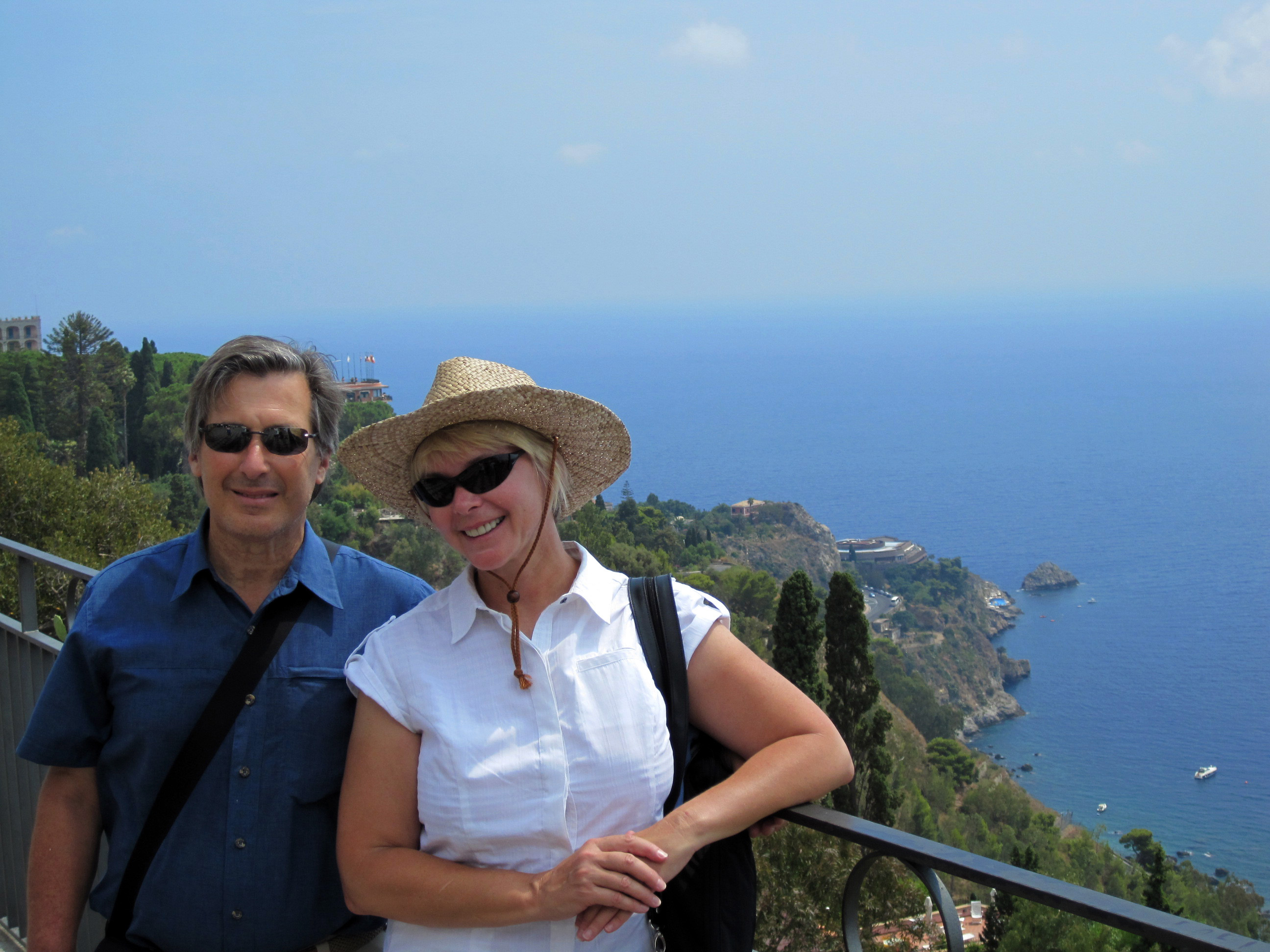 TAORMINA
TAORMINA
Taormina is the beautiful coastal mountain city between Messina and Catania. It could be the most visited place in all of Sicily.
One of the big attractions of this city in the Greek Theatre built during the reign of Dionysius the Elder. It overlooks the Ionian sea as well as Mt Etna and provides a spectacular backdrop for any performance. There is a renown film festival at the Greek Theatre every summer as well as several music concerts. When we were last here in 2003, we got to hear (and see) a concert by Diana Krall. Halfway through the show she stopped to take a photo of the audience, remarking that she had never played a gig in such an amazing location.
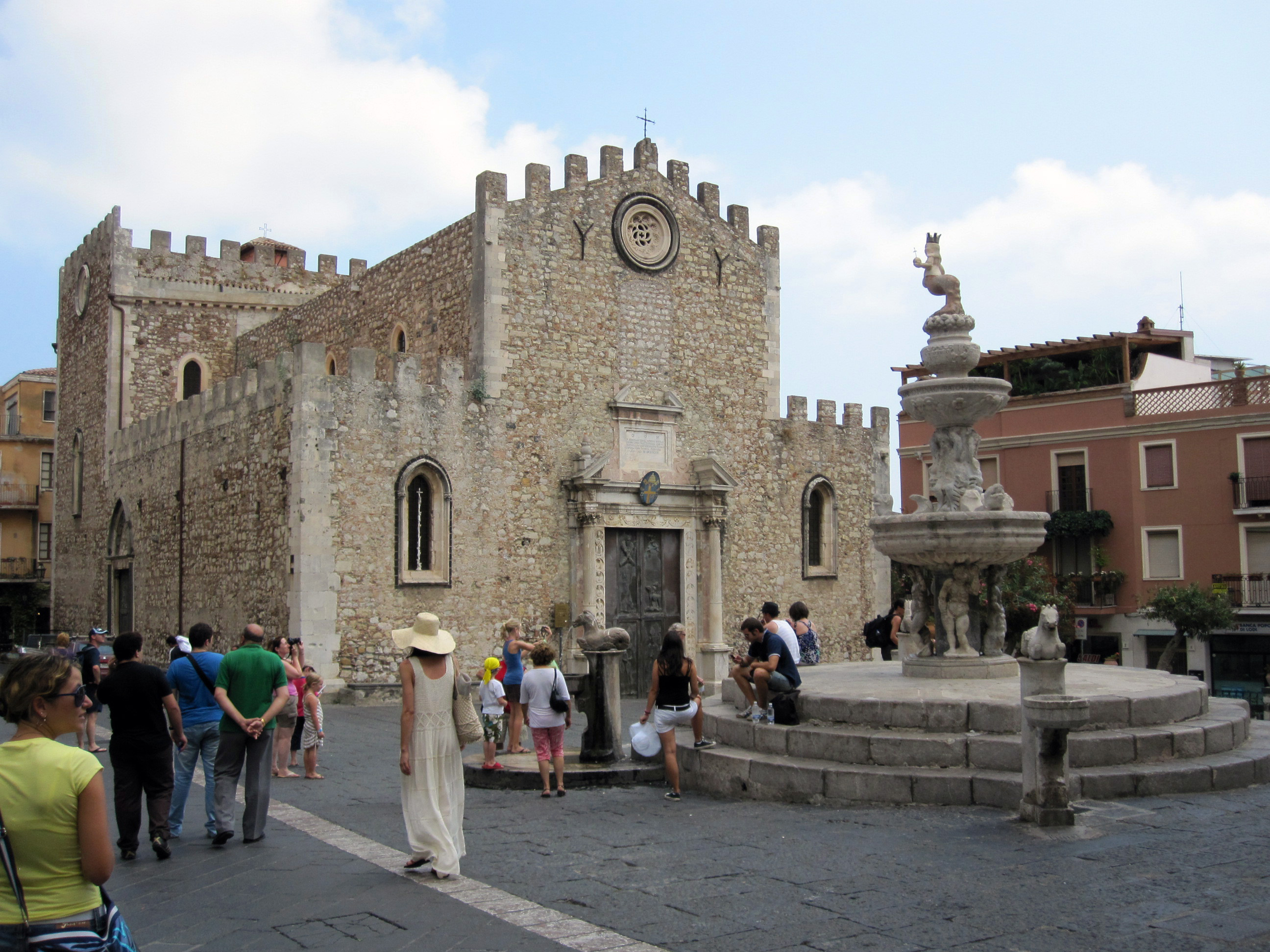 Taormina has kept a lot of it’s 14th, 15th and 16th century charm. It even has some great examples of Sicilian Baroque. It also has more souvenir and ceramic shops than any other Sicilian city we’ve been to, selling Caltagirone style traditional ceramics, modern garden sculptures and several sizes of the three legged Sicilian symbol, the “trinacria”, a symbol that actually goes back to Magna Graecia.
Taormina has kept a lot of it’s 14th, 15th and 16th century charm. It even has some great examples of Sicilian Baroque. It also has more souvenir and ceramic shops than any other Sicilian city we’ve been to, selling Caltagirone style traditional ceramics, modern garden sculptures and several sizes of the three legged Sicilian symbol, the “trinacria”, a symbol that actually goes back to Magna Graecia.
The medusa head in the center of the triniclia represents the protection of the goddess Athena, the patron goddess of the island, as well as her destructive aspects , in case you’re thinking of pissing her off. The 3 legs emanating from her head represent the 3 points of the triangular island; ancient Lilybaeum (now Marsala); ancient Pachynus (modern day Capo Passero below Siracusa) and ancient Pelorus (modern day Punta del Faro north of Messina). You could spend hours walking through the shops, watching people, snapping photos from the amazing bellavistas and eating in any of the hundreds of restaurants. If you’ve been here before, you’ll probably last about 3-4 hours and then go back to the real Sicily.
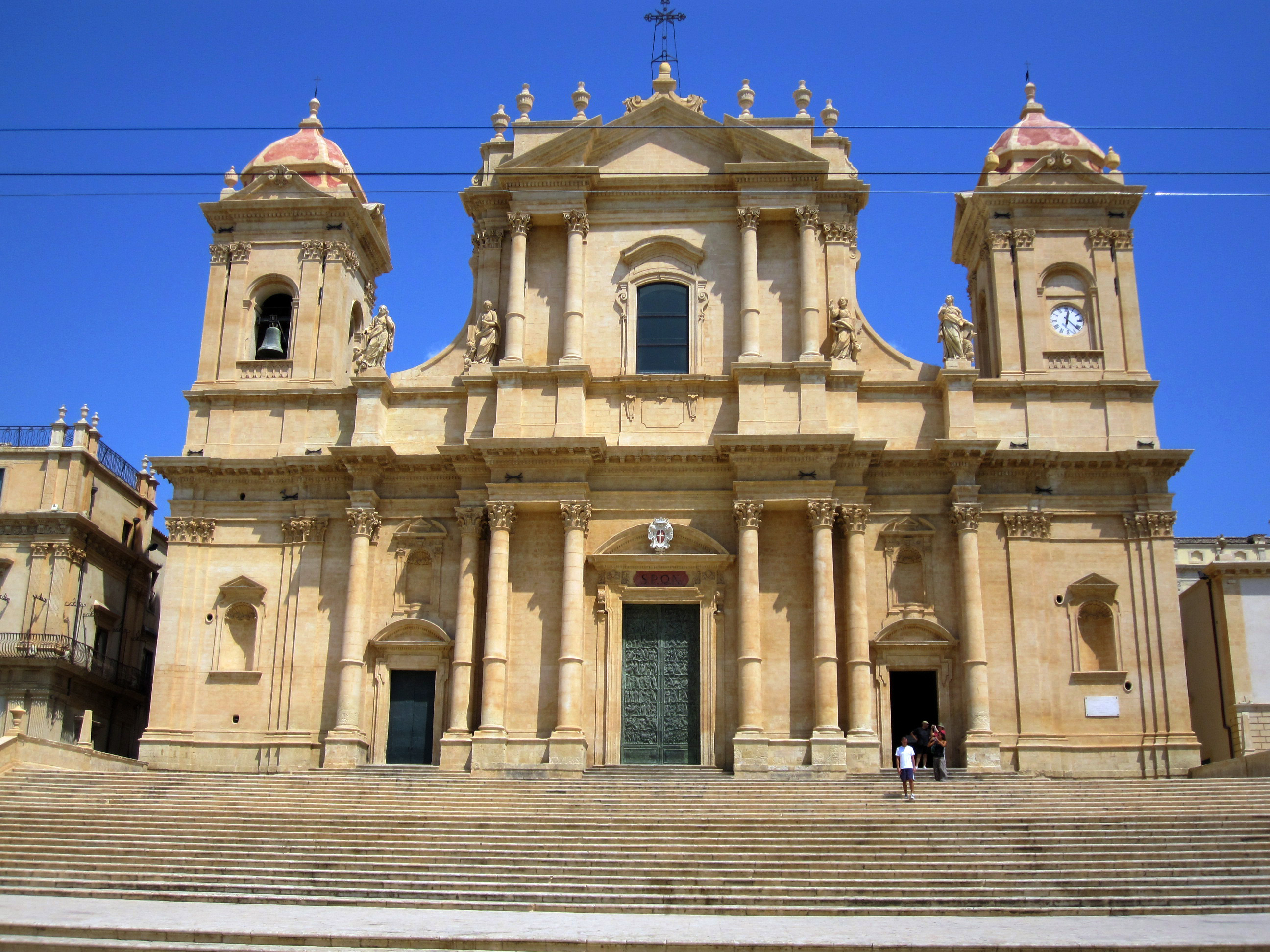
You must be logged in to post a comment.